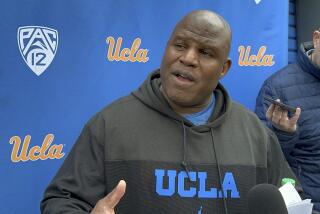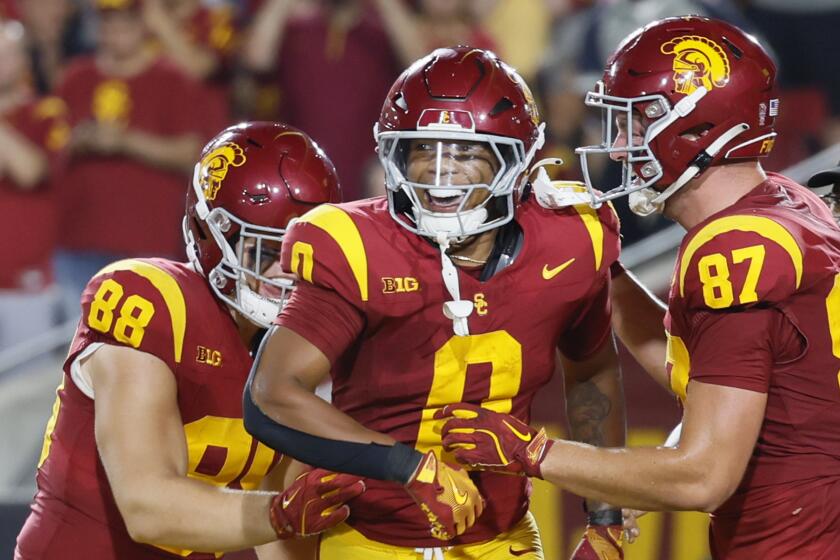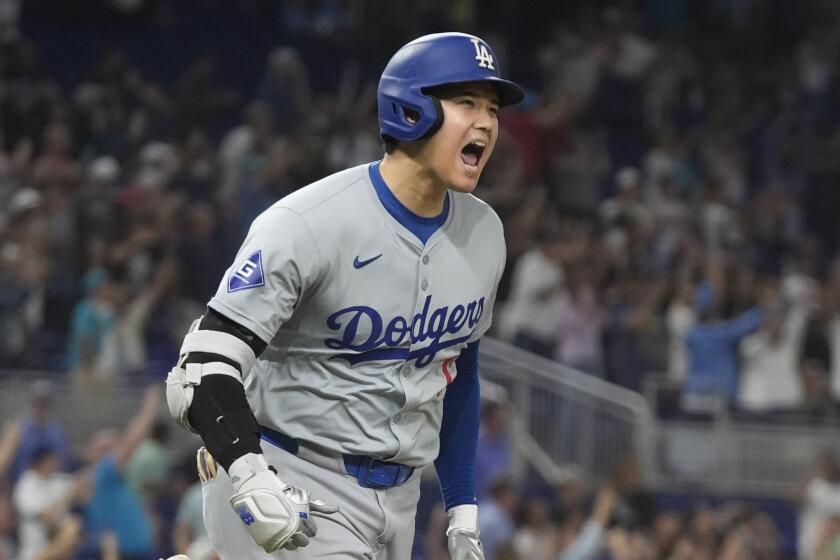Walking Lesson in Anatomy : Jeff Mahlstede Plays Through Pain for Arizona State
Point a finger at any part of Jeff Mahlstede’s body and there’s a good chance it is broken, has been broken, will be operated on, has been operated on or, on this fortunate day, is merely sore.
Right ankle. During the regular season, Mahlstede spends three days out of every week on crutches. This is to rest a stress fracture, which has been with Mahlstede since late August but hasn’t prevented him from starting seven games as Arizona State’s free safety. From Sunday through Tuesday, it’s crutches. From Wednesday through Friday, it’s practice. And on Saturday, more pain.
Right knee. He sports a surgical scar from a past problem with torn cartilage.
Left knee. It’s also marked by a scar, but this one is protected during games by a metal brace.
Back. Mahlstede sat out three full seasons after high school graduation with a fractured lumbar vertebra. It still bothers him on occasion, mainly on particularly cold days or particularly hard hits.
Right shoulder. Here, the rotator cuff is torn. The injury ended his career as a quarterback at Fullerton College and was re-aggravated during a Nov. 14 game against California. Surgery is tentatively scheduled for January.
“I’m going to see a specialist in Inglewood after the game,” Mahlstede says, referring to Wednesday’s Freedom Bowl in Anaheim Stadium, which will pit Arizona State against Air Force. “I’ve got to get my body put back together.”
One might wonder why such a body remains in a football uniform, let alone a starting lineup. Mahlstede’s belongs in bed, or in traction, or at least on the bench.
But in the Arizona State secondary, health is a relative thing and after an incredible season of injury and attrition, Mahlstede ranks among the fittest four defensive backs left on the Sun Devil roster, crutches and braces and all.
Two regulars--cornerback Arthur Parker and nickel back Jeff Joseph--were lost for the season with knee ligament damage. A third, free safety Bernard Jones, suffered a career-ending neck injury in Arizona State’s fourth game. Both strong safeties--Robby Boyd and Nathan LaDuke--missed at least three weeks with leg and foot ailments.
“I’ve never seen a secondary so demolished,” said Pat Henderson, the Sun Devils’ defensive backfield coach. “We started out with what we thought was the best secondary in the country. At least no secondary was more experienced. Now, we’re playing three freshmen that we had planned to red-shirt this season.”
And they’re starting Mahlstede, a 24-year-old walking disabled list.
“He’s the last one standing,” Henderson said.
Since replacing Jones in the season’s fifth week, Mahlstede has made 53 tackles--30 unassisted--and intercepted 2 passes. One came against UCLA’s Troy Aikman, which places Mahlstede in a select group. As a team, UCLA had only six passes intercepted all season.
But by simply stepping onto the playing field for seven consecutive weeks, Mahlstede is a success story. As Henderson puts it, “It’s amazing that he’s playing, really.”
But Mahlstede has grown accustomed to it.
“I’ve had an injury-prone career,” he deadpans. “I’ve spent a lot of time in rehab centers. I don’t believe there’s ever been a time when I have played without pain.”
The record supports Mahlstede.
He first hurt his lower back while wrestling for Santa Fe Springs High School, an injury that went from nagging to career-threatening when Mahlstede fractured the third lumbar vertebra while preparing for a prep all-star football game in 1982. It took three years of rehabilitation before doctors would again clear him to play football.
Mahlstede left a full-time job with an aerospace corporation to resume his career as a quarterback. He enrolled at Fullerton College in 1985, but by the time the 1986 season rolled around, Mahlstede was a full-time defensive back. The forward pass becomes difficult when the shoulder doing the passing has a torn rotator cuff.
So Mahlstede switched positions--and made the transition so smoothly that he was named to JC Gridwire’s all-America team as a sophomore. He intercepted 5 passes and made 51 unassisted tackles for the Hornets in 1986.
Those credentials interested Arizona State enough to recruit Mahlstede. But Coach John Cooper hadn’t planned on playing him much--not in a secondary that returned three starters from the Sun Devils’ Rose Bowl championship squad. And especially not after the foot stress fracture that wiped out Mahlstede in fall practice.
Circumstances changed quickly, however, and by October, Mahlstede could be found limping around the Arizona State defensive backfield. And he’ll be out there again Wednesday, starting in a postseason bowl game.
What is it like to play major-college football on a stress fracture?
“It feels like a real bad sprain, except sometimes it sends a sharp pain right up the leg,” Mahlstede said.
When does that happen?
“When I have to plant on it,” he says.
That isn’t often. Only on running and passing plays.
“Sure, it hurts,” Mahlstede said. “But when you practice so many days out of the year, I’ll do whatever I have to do to be on the field on Saturday.
“It’s painful, and it hinders my performance somewhat, but it’s not keeping me from doing a capable job out there. If I thought I was a hindrance to the team, that’d be a different story.”
Henderson estimates that Mahlstede is playing at “about 75%” capacity.
“He has trouble changing direction,” Henderson said. “He was never a real fast free safety, anyway. His instincts and his intelligence are what interested us in him in the first place. He had great intangibles, and those intangibles are getting him by now.”
After the Freedom Bowl, Mahlstede is looking forward to some time off and a decision about surgery on the rotator cuff. If the operation will enable him to finally play without pain, he’ll have it done. If not, Mahlstede admits he’ll consider bypassing his senior year of eligibility.
“I definitely want to play, but to do that, I have to deal with these other things,” he said. “If there’s no pain, I’ll play.”
Henderson said he can understand Mahlstede walking away after the Freedom Bowl, if it develops that way.
“Nobody likes to compete at less than full speed,” Henderson said. “Basically, Jeff is sacrificing himself for the team. The other players really respect him, because they understand what he’s going through.
“But he’s been hurt so often. His medical history is phenomenal--it goes on forever. And he says his shoulder bothers him more now than ever. I think he’s tired of playing in pain. I wouldn’t be surprised if he made this his last year, if he couldn’t come back and compete at full speed.”
It’s a matter of pain threshold. And, eventually, there comes a time when a body can no longer be carried over that threshold.
Even Jeff Mahlstede’s.
More to Read
Go beyond the scoreboard
Get the latest on L.A.'s teams in the daily Sports Report newsletter.
You may occasionally receive promotional content from the Los Angeles Times.










